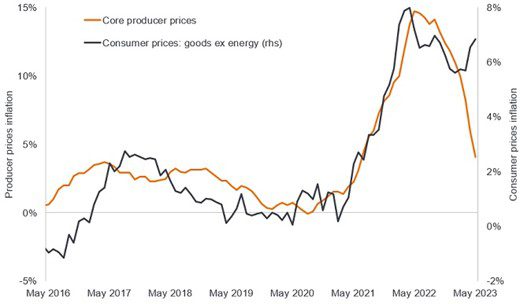UK core PPI is falling, historically CPI tracks this downwards
UK-unique factors such as post-Brexit labour market shortages are abating, as non-EU arrivals increase.
The BoE’s aggressive policy to tackle supply-side inflation is bound to create a recession – albeit a shallow one.
Prospects of a weakening economy may lead to softer labour markets. Alongside easing supply -side pressures and Sterling’s recent strength, inflation is likely to fall in the coming months.
UK Gilts are emerging as an investment opportunity
Despite marginal decreases, the UK headline CPI inflation rate has remained far above the BoE’s 2% target rate, whilst core inflation appears stickier than in the US and EU. They remain at 7.9% and 6.9% respectively, in July.
In this piece, however, we will look at why these pressures should soon abate, what this may mean for interest rates, and why this makes UK gilts an attractive proposition.
Whilst much of the rhetoric surrounding the UK’s inflationary picture appears gloomy, there is insufficient emphasis on impact of time lags in feeding through to inflation data.
Globally, the UK’s Energy Price Guarantee (EPG) was a somewhat unique response to the commodity price spikes caused by the Russia-Ukraine conflict, bringing the cost of a typical household’s energy bill down to £2,500 per annum. Ofgem’s new unit cap, which has only been in effect from 1st July, brings the average bill down to £2,074. A consistently strengthening Pound also makes commodity imports cheaper. Therefore, it is imperative that we wait for these changes to filter through to inflation figures.
Monetary policy also takes effect with a lag. On average, it takes roughly 18 months for the impact of a single rise in the base rate to carry through fully into the price level. Though the UK remains embroiled in a turbulent cost-of-living crisis, the BoE’s rate hike cycle began exactly 18 months ago, with a relatively tame 15bps rise in December 2021. Patience therefore remains a virtue.
In addition, the UK Producer Price Index (PPI) has been trending down consistently in 2023.

The above chart also shows a clear proportional long-run relationship between producer and core consumer prices, but with an evident time lag in core inflation.
The tightness of UK labour markets has been a key driver of inflation and can be attributed to low net migration of labour and a shrinking workforce. However, positive signs are now emerging. First, the number of non-EU nationals has increased by 287,000 between 2021 and 2022 – the increase is attributed primarily to people arriving in the UK for work-related reasons. In addition, economic inactivity has been falling consistently since February, and has recorded a 0.3% YoY decline. Labour demand, as measured by the Permanent Placing Index, is also easing. A mix of easing demand and higher supply should control high nominal wage growth, and feed through to lower inflation rates.
It is also very plausible that the UK is past the worst of its inflation woes. In H1 2023, state-dependent firms (those that set prices in response to events) have raised prices by more than time-dependent firms (those that change prices at regular fixed intervals). This is likely because they harbor lower inflation expectations for 2024 than time-dependent firms. The majority (60%) of UK firms are state-dependent. Overall, most UK firms have low inflation expectations, which gives rise to the thesis that the bulk of price rises may have occurred in H1. This may lead to reduced price pressures into H2 and 2024.
At present, the base rate in the UK sits at 5.25%. With price pressures soon to abate, markets have also revised their peak UK rate expectations downward, from 6% to 5.8%. Even though the BoE has stated that rates will remain historically high for 2 years, the end of the hiking cycle appears to be near.
With UK 1-year gilts yielding 5.036% and 10-years yielding 4.283%, we see an investment opportunity emerging. After the political debacle in the autumn of 2022, the UK government is on a path of fiscal prudence, which offers further support for gilts.
In conclusion, UK yields are at historically high levels, and stand at higher levels than US and EU bonds. With this in mind, we have a positive view on UK gilts to benefit from higher yields, as investors begin to flow back into this asset class.
Disclaimer: ‘Where the business has expressed opinions, they are based on current market conditions, they may differ from those of other investment professionals and are subject to change without notice. The information contained within this communication is believed to be reliable but Realm Investment Management Limited does not warrant its completeness or accuracy.
This communication is not intended as a recommendation to invest in any particular asset class, security or strategy. Regulatory requirements that require impartiality of investment/investment strategy recommendations are therefore not applicable nor are any prohibitions to trade before publication. The information provided is for illustrative purposes only, it should not be relied upon as recommendations to buy or sell investments.’




